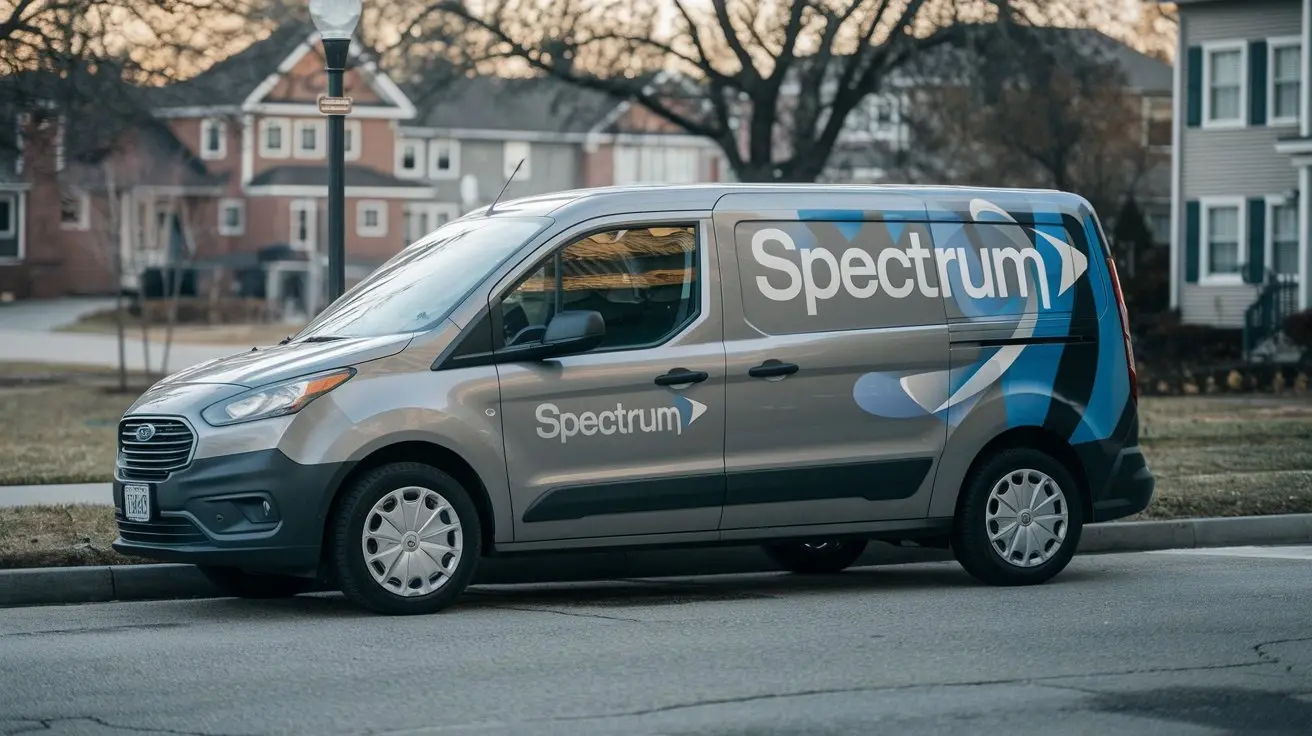Spectrum Is Now The Largest Cable TV Provider In The U S

Spectrum has officially ascended to the pinnacle of the U.S. cable TV market, surpassing all competitors to become the nation's largest provider. This monumental shift signifies a new era in home entertainment and internet services, impacting millions of households across America. This comprehensive guide explores what this means for consumers and the industry.
Understanding the Landscape: What Does "Largest Provider" Mean?
The title of "largest cable TV provider in the U.S." is not merely a symbolic badge; it reflects significant market power and reach. As of 2025, Charter Communications, operating under the Spectrum brand, has solidified its position by accumulating the highest number of subscriber households for traditional cable television services. This metric, often measured by the total number of active video, internet, and voice subscribers, indicates a company's ability to influence market trends, negotiate favorable terms with content providers, and potentially shape the future of home entertainment delivery. It signifies a dominant force in an industry that has seen considerable consolidation and evolution.
Spectrum's Ascension: The Road to Dominance
Spectrum's rise to become the largest cable TV provider in the U.S. is a story of strategic foresight, aggressive expansion, and a keen understanding of market dynamics. This ascent wasn't an overnight phenomenon but rather a culmination of deliberate actions over several years. Charter Communications, the parent company, has been instrumental in this growth, employing a multi-pronged strategy to outpace its rivals.
Strategic Acquisitions and Mergers
One of the most significant drivers of Spectrum's market dominance has been its series of strategic acquisitions and mergers. Charter has a well-documented history of acquiring smaller cable operators and, most notably, Time Warner Cable and Bright House Networks. These large-scale consolidations allowed Charter to rapidly expand its geographic footprint, absorb existing customer bases, and achieve economies of scale. The integration of these companies under the unified Spectrum brand streamlined operations, marketing, and customer service, presenting a cohesive and powerful entity to consumers.
For instance, the 2016 acquisition of Time Warner Cable and Bright House Networks was a transformative event. This deal alone added millions of subscribers and significantly broadened Spectrum's service areas across numerous major metropolitan markets. These mergers weren't just about acquiring more customers; they were about acquiring valuable infrastructure, skilled workforces, and established market positions. By integrating these entities, Charter was able to leverage existing assets and operational efficiencies, paving the way for further growth.
Aggressive Network Expansion
Beyond mergers, Spectrum has also invested heavily in expanding its high-speed internet and advanced TV network infrastructure. This involves upgrading existing coaxial cable networks to deliver faster speeds and more robust services, as well as extending fiber optic lines into new territories. In an era where high-speed internet is increasingly essential for work, education, and entertainment, this focus on network improvement has been crucial.
Spectrum's commitment to network expansion is evident in its ongoing deployment of DOCSIS 3.1 and DOCSIS 4.0 technologies, which enable multi-gigabit internet speeds over its hybrid fiber-coaxial (HFC) infrastructure. This technological advancement allows Spectrum to compete more effectively with fiber-to-the-home providers and meet the growing demand for bandwidth. The company has also been proactive in building out its network in underserved and unserved areas, a strategy that not only broadens its customer base but also addresses digital equity concerns.
Product Innovation and Bundling
Spectrum has also focused on innovating its product offerings and creating attractive bundled packages. Recognizing that consumers increasingly seek integrated solutions for their connectivity needs, Spectrum has aggressively pushed its triple-play (TV, internet, voice) and even its "quad-play" offerings, which often include mobile services. These bundles provide convenience and cost savings for consumers, encouraging them to consolidate their services with a single provider.
The company has continuously updated its TV interface, introduced advanced DVR capabilities, and expanded its on-demand content library. Furthermore, Spectrum Mobile, launched in 2018, has been a significant growth area. By leveraging its extensive Wi-Fi network and partnering with a major carrier, Spectrum has been able to offer competitive mobile plans, further enhancing its bundle appeal and capturing a larger share of household spending on telecommunications. This integrated approach makes it harder for consumers to switch away, contributing to subscriber retention and overall market share growth.
Comparing the Giants: Spectrum vs. Other Major Providers (2025)
To truly appreciate Spectrum's new status as the largest cable TV provider, it's essential to compare its current standing with other major players in the U.S. telecommunications and entertainment landscape. The competitive environment is dynamic, with traditional cable companies, satellite providers, and increasingly, streaming services vying for consumer attention and dollars. However, when focusing on traditional wired broadband and video delivery, Spectrum's position is particularly strong.
Subscriber Numbers and Market Share
As of early 2025, Spectrum, under Charter Communications, boasts the highest number of traditional cable TV subscribers in the United States. While precise, real-time figures fluctuate, industry analyses consistently place Spectrum at the forefront of this segment. This dominance is a result of the strategic consolidations and organic growth discussed earlier.
Let's consider a comparative overview (estimates based on Q4 2024 and early 2025 projections):
| Provider | Estimated Cable TV Subscribers (Millions) | Estimated Total Broadband Subscribers (Millions) | Primary Service Area |
|---|---|---|---|
| Spectrum (Charter) | ~25-27 | ~32-34 | Nationwide (major markets) |
| Xfinity (Comcast) | ~18-20 | ~33-35 | Nationwide (major markets) |
| Cox Communications | ~3-4 | ~6-7 | Regional (select states) |
| Altice USA | ~2-3 | ~4-5 | Regional (select states) |
| DirecTV (AT&T Legacy) | ~5-6 (satellite focus) | ~1-2 (DSL/fiber bundles) | Nationwide |
| Dish Network | ~6-7 (satellite focus) | ~0.5-1 (DSL/fiber bundles) | Nationwide |
It's crucial to note the distinction between cable TV subscribers and broadband subscribers. Comcast's Xfinity often rivals or slightly exceeds Spectrum in total broadband subscribers due to its extensive network reach. However, in the specific category of *cable TV* subscribers, Spectrum has emerged as the leader. Satellite providers like DirecTV and Dish Network, while significant players, are experiencing ongoing subscriber declines in their traditional TV offerings, a trend that has accelerated as consumers shift to streaming and alternative entertainment options.
Service Offerings: TV, Internet, and Mobile
Spectrum's comprehensive service portfolio is a key factor in its market leadership. Beyond traditional cable TV packages, they offer a wide array of high-speed internet tiers, VoIP phone services, and a growing mobile offering.
- TV Services: Spectrum provides a range of cable TV packages, from basic local channels to premium sports and entertainment tiers. They also offer a streaming-only option, Spectrum TV Choice, and Spectrum TV Stream, catering to cord-cutters and cord-nevers.
- Internet Services: This is arguably Spectrum's strongest segment. They are known for offering high-speed internet with competitive introductory pricing and reliable performance, leveraging their upgraded HFC network. Multi-gigabit speeds are increasingly available in many areas.
- Voice Services: Traditional landline phone service remains a component of their bundled offerings, providing a stable revenue stream and further entrenching customers.
- Mobile Services: Spectrum Mobile has been a strategic addition, allowing the company to compete in the lucrative mobile market. It functions as a Mobile Virtual Network Operator (MVNO), utilizing Verizon's network. This allows Spectrum to offer unlimited data plans and family plans, often at attractive prices when bundled with other services.
Other providers like Xfinity also offer similar bundled services. However, the sheer scale of Spectrum's cable TV subscriber base, combined with its robust internet and growing mobile presence, positions it uniquely. Providers like Cox and Altice USA are significant regional players but lack Spectrum's national reach in terms of total subscriber numbers across all service categories.
Customer Satisfaction and Perception
Customer satisfaction is a complex metric and often a point of contention for large utility-like service providers. Historically, cable companies have faced challenges in this area. However, recent trends suggest a nuanced picture.
According to various consumer surveys and industry reports from 2024 and early 2025, Spectrum generally performs moderately well, often ranking among the top tier of cable providers. While not always achieving the highest scores, they tend to outperform many of their direct cable competitors in areas like reliability and internet speeds. Customer perception is often influenced by the availability of faster internet tiers and the perceived value of bundled packages.
Xfinity (Comcast) often finds itself in a similar position, with strong network performance but mixed customer service reviews. Satellite providers like DirecTV and Dish Network, while offering extensive channel lineups, often face challenges related to installation, equipment reliability, and the perceived value proposition compared to streaming alternatives. The perception of Spectrum as the "largest" provider can sometimes lead to an expectation of superior service, but their actual performance in customer satisfaction surveys is generally competitive within their industry segment.
The Consumer Impact: What This Means for You
Spectrum's ascendancy to the position of the largest cable TV provider in the U.S. has tangible implications for millions of consumers. Understanding these changes can help individuals make informed decisions about their home entertainment and connectivity services.
Pricing and Plan Variations
As the largest provider, Spectrum holds significant leverage in pricing. This can manifest in several ways:
- Competitive Pricing: To maintain and grow its market share, Spectrum often employs aggressive introductory pricing for new customers and those signing up for bundles. This can make their offers appear very attractive compared to competitors.
- Bundling Strategies: Spectrum heavily promotes bundled packages (TV, internet, voice, mobile). These bundles often offer a lower per-service cost than subscribing to each individually. The more services you bundle, the greater the potential savings.
- Price Increases: Conversely, once a customer is locked into a contract or a promotional period ends, Spectrum, like all major providers, is known to implement regular price increases. The scale of their operation might allow them to absorb some costs, but these increases are a common reality for long-term subscribers.
- Tiered Offerings: Spectrum offers a wide range of plans for TV and internet. The "largest provider" status means they have the infrastructure to support diverse tiers, from basic internet to multi-gigabit speeds, and from limited basic TV packages to comprehensive channel lineups. Consumers need to carefully select the tier that matches their actual usage to avoid overpaying.
For consumers, this means it's crucial to be aware of introductory offers versus standard rates and to understand the exact features and limitations of any plan chosen. Negotiating at the time of signup or renewal is often key to securing the best possible pricing.
Service Quality and Reliability
Spectrum's extensive network infrastructure, built through organic expansion and acquisitions, generally translates to reliable service for many customers. Their investment in upgrading to DOCSIS 3.1 and preparing for DOCSIS 4.0 means that many areas now have access to very high-speed internet, which is critical for modern households.
- Internet Speed: Spectrum is often praised for offering high-speed internet options that are competitive with fiber providers in many areas. Their network is designed to handle increasing bandwidth demands for streaming, gaming, and remote work.
- TV Service Stability: While cable TV can be susceptible to local outages (e.g., power issues, severe weather), Spectrum's robust infrastructure aims for consistent delivery of live TV channels and on-demand content.
- Network Congestion: In densely populated areas, like any large provider, Spectrum can experience network congestion during peak usage times. However, their continuous network upgrades are designed to mitigate this.
- Consistency Across Regions: While Spectrum operates nationally, the quality and availability of specific services can vary by region due to the underlying infrastructure inherited from previous owners and local investment priorities.
The "largest provider" status implies a significant investment in maintaining and upgrading this infrastructure to ensure a baseline level of quality and reliability across its vast service footprint. This is a key advantage over smaller, regional players who might not have the same capital to invest in cutting-edge technology.
Customer Support Experience
Customer support is a critical touchpoint for any service provider, and large companies like Spectrum often face the challenge of managing a vast customer base with diverse needs.
- Call Center Operations: Spectrum utilizes a combination of in-house and outsourced call centers. Experiences can vary significantly depending on the agent, the issue, and the time of day. Common complaints often revolve around long wait times and difficulty resolving complex issues on the first contact.
- Online Support and Self-Service: Spectrum has invested in its online portal and mobile app, offering self-service options for billing, troubleshooting, and account management. These tools can be efficient for simple tasks.
- Technician Visits: For installations and in-home repairs, the quality of technician service is paramount. Spectrum aims for professional and timely service, but experiences can differ based on local staffing and scheduling.
- Escalation Processes: For persistent issues, navigating Spectrum's escalation process can be challenging. However, their size means there are often multiple channels for recourse, including customer advocacy teams and regulatory complaints if necessary.
While Spectrum's customer support might not always receive top marks in independent reviews, their scale means they handle an enormous volume of customer interactions daily. The key for consumers is to be prepared with clear information about their issue and to persist in seeking resolution.
Innovation and Future Offerings
As the largest player, Spectrum is positioned to be a significant driver of innovation in the industry. Their substantial revenue allows for considerable investment in research and development, as well as the deployment of new technologies.
- Next-Generation Networks: Spectrum is at the forefront of deploying DOCSIS 4.0, which promises symmetrical multi-gigabit speeds, essential for future applications like the metaverse, advanced cloud computing, and enhanced remote collaboration.
- 5G Integration: With the expansion of Spectrum Mobile, the company is increasingly focused on integrating its Wi-Fi network with cellular services, potentially offering seamless connectivity across different platforms.
- Content Delivery: While not a content producer like Netflix or Disney+, Spectrum plays a crucial role in delivering content. Their network infrastructure is vital for streaming services, and their own platform continues to evolve with new features and app integrations.
- Smart Home and IoT: Like other major providers, Spectrum is exploring opportunities in the smart home ecosystem, potentially integrating services like home security, automation, and enhanced connectivity for Internet of Things (IoT) devices.
The company's size and market leadership mean that its strategic decisions regarding technology adoption and service development will have a ripple effect across the entire industry, influencing what consumers can expect in terms of speed, features, and service integration in the coming years.
Broader Industry Implications
Spectrum's new status as the largest cable TV provider in the U.S. sends ripples far beyond individual consumer choices. It signifies a significant shift in the competitive landscape, potentially influences regulatory considerations, and impacts the ecosystem of content creation and distribution.
Shifting Competition Dynamics
The consolidation that led to Spectrum's dominance has reshaped the competitive arena. With fewer, larger players, the market becomes more concentrated. This means:
- Reduced Choice in Some Areas: While Spectrum operates in many markets, the intense competition from mergers means that in certain regions, consumers may have fewer choices for high-speed internet and traditional cable TV. This can reduce the pressure on providers to compete solely on price.
- Focus on Bundling and Retention: With fewer direct competitors in certain areas, providers like Spectrum may focus more on retaining existing customers through bundled offers and loyalty programs rather than aggressive new customer acquisition based purely on price.
- Competition from Other Verticals: While Spectrum leads in cable TV, the competition for the consumer's entertainment dollar is broader. Streaming services (Netflix, Disney+, Max), direct-to-consumer offerings from networks, and over-the-air broadcasts all vie for attention. Spectrum's challenge is to keep customers engaged with its TV services amidst this fragmented media landscape.
- Increased Importance of Broadband: The real battleground for many providers, including Spectrum, is broadband internet. As the largest cable provider, Spectrum's dominance in this area is crucial for its overall market power. This puts pressure on companies like AT&T (fiber), Verizon (5G Home Internet, fiber), and T-Mobile (5G Home Internet) to innovate and expand their own networks.
The market is no longer just about cable TV; it's about the entire connectivity and entertainment package. Spectrum's leadership in one segment gives it a strong foundation to compete across all.
Potential Regulatory Scrutiny
When a single entity achieves significant market dominance, it often attracts the attention of regulatory bodies. As the largest cable TV provider, Spectrum could face increased scrutiny from:
- Antitrust Concerns: While the mergers that led to this position have already been approved, sustained market leadership can lead to ongoing discussions about market power and potential anti-competitive practices. Regulators may monitor pricing, service availability, and merger activities more closely.
- Net Neutrality Debates: As a major internet service provider, Spectrum's stance and practices related to net neutrality will remain under the spotlight. Policies regarding traffic management, throttling, and prioritization of services can have significant implications for content providers and consumers.
- Broadband Deployment Mandates: With its extensive reach, Spectrum may be subject to increasing pressure or incentives to expand broadband access to unserved and underserved rural and urban areas. Government initiatives aimed at closing the digital divide could involve partnerships or mandates for major providers.
- Consumer Protection Regulations: The sheer volume of Spectrum's customer base means that any issues related to billing transparency, contract terms, or service quality can become a focal point for consumer protection agencies.
While Spectrum operates within established regulatory frameworks, its leading position ensures that it will remain a key subject in ongoing discussions about telecommunications policy in the United States.
Influence on Content Creators and Networks
Spectrum's position as the largest cable TV provider grants it considerable influence over the content ecosystem. This influence stems from:
- Negotiation Power: When contracts are up for renewal, Spectrum's substantial subscriber numbers give it significant leverage in negotiating carriage fees with cable networks and content providers. This can impact the wholesale cost of content, which in turn affects retail pricing for consumers.
- Channel Placement and Promotion: Spectrum has the ability to influence which channels are prominently featured in its channel lineups and promotional materials. This can affect the visibility and reach of various networks and programming.
- Data and Insights: As a large provider, Spectrum collects vast amounts of data on viewing habits. This data can be invaluable for understanding consumer preferences, which can inform programming decisions by networks and content creators, and even guide Spectrum's own content acquisition strategies.
- Support for New Content Models: Spectrum's infrastructure is essential for the delivery of all forms of video content, including linear TV, on-demand, and streaming. As they continue to innovate their platforms, they can enable or hinder the adoption of new content delivery models and interactive features.
This influence means that Spectrum's decisions can have a direct impact on the diversity of content available to consumers, the business models of media companies, and the overall direction of the television industry.
Navigating Your Options: Making the Right Choice
With Spectrum now the largest cable TV provider, understanding how to navigate your service options is more important than ever. Whether you're a current Spectrum customer, considering switching, or exploring alternatives, a structured approach can ensure you get the best value and service for your needs.
Step 1: Evaluate Your Current Needs
Before looking at any provider, take stock of what you actually use and need:
- Internet Usage: How many devices connect simultaneously? What do you primarily use the internet for (streaming HD/4K video, gaming, remote work, basic browsing)? This will determine the required speed tier.
- TV Viewing Habits: How many channels do you watch regularly? Are you interested in premium sports, movie channels, or specific niche programming? Do you rely heavily on live TV, or do you prefer on-demand content and streaming apps?
- Voice Services: Do you still use a landline? If so, how often?
- Mobile Usage: How much data do you and your family consume on mobile devices? Are you looking for unlimited plans or pay-as-you-go options?
- Budget: What is your realistic monthly budget for these services?
Being honest about your usage will prevent you from overpaying for services you don't need or underpaying and experiencing frustration with slow speeds or limited channels.
Step 2: Research Available Providers in Your Area
Your options are highly dependent on your geographic location. Use online tools and provider websites to see who offers services at your address.
- Spectrum: Check their website for availability and specific plans in your area.
- Comcast (Xfinity): Another major player with extensive coverage.
- Fiber Providers: Look for companies like AT&T Fiber, Verizon Fios, Google Fiber (in select cities), or local municipal fiber initiatives. Fiber often offers superior speeds and reliability.
- Satellite Providers: DirecTV and Dish Network offer TV services nationwide, but their internet options are typically limited to DSL or partner services.
- 5G Home Internet: Providers like T-Mobile Home Internet and Verizon 5G Home Internet are expanding rapidly and can be a good alternative, especially in areas where wired options are limited or expensive.
- MVNOs for Mobile: Consider mobile virtual network operators (MVNOs) that use major carrier networks if Spectrum Mobile's bundle isn't the best fit.
Don't assume you know what's available; always verify directly at your address.
Step 3: Compare Packages and Pricing
Once you know who services your address, dive into the details. Pay close attention to:
- Introductory vs. Standard Pricing: What is the price for the first 12-24 months, and what will it be afterward?
- Contract Length: Are you locked into a contract? What are the early termination fees?
- Equipment Rental Fees: Modems, routers, DVRs – these can add significant costs.
- Installation Fees: Are there charges for professional installation?
- Data Caps: Does the internet plan have data limits? (Spectrum generally doesn't for its internet service, but it's good to confirm).
- Bundling Discounts: How much do you save by combining services?
- Promotional Offers: Are there any limited-time deals or sign-up bonuses?
Create a spreadsheet to compare apples to apples. Don't just look at the headline price; consider the total cost over a year or two and the included features.
Step 4: Read Customer Reviews
While official statistics can be misleading, real-world customer experiences offer valuable insights.
- Independent Review Sites: Look at sites like Consumer Reports, PCMag, CNET, and local forums.
- Focus on Specifics: Pay attention to reviews mentioning reliability, internet speed consistency, customer service responsiveness, and billing accuracy for your specific provider and service type.
- Regional Differences: Customer experiences can vary significantly by region due to local infrastructure and management.
Remember that people are often more motivated to leave negative reviews than positive ones, so look for patterns rather than isolated incidents.
Step 5: Negotiate Terms and Contracts
Never accept the first offer. Large providers like Spectrum expect negotiation.
- Be Prepared: Know what you want and what you're willing to pay.
- Ask About Promotions: Inquire about any current deals for new or existing customers.
- Bundle Wisely: See if bundling services offers a better overall value.
- Be Willing to Walk Away: Sometimes, threatening to switch to a competitor (even if you don't fully intend to) can prompt better offers.
- Confirm Everything in Writing: Ensure all agreed-upon terms, pricing, and contract lengths are documented before signing up.
Negotiation is a standard part of the process for these large service providers.
Conclusion: The New Era of Connectivity
Spectrum's definitive rise to become the largest cable TV provider in the U.S. marks a significant milestone in the telecommunications industry. This achievement, fueled by strategic acquisitions, aggressive network expansion, and innovative product bundling, reshapes the competitive landscape. For consumers, this dominance presents a dual-edged sword: the potential for competitive pricing and advanced services, balanced against the realities of a concentrated market and the ever-present possibility of price adjustments.
As the market leader, Spectrum's investments in next-generation technologies like DOCSIS 4.0 and its integration of mobile services signal a future where seamless, high-speed connectivity is paramount. However, the importance of robust customer support, transparent pricing, and reliable service remains unchanged. Therefore, consumers must remain diligent in evaluating their needs, researching all available options, and actively negotiating for the best possible value. By understanding the implications of Spectrum's market leadership and employing a strategic approach to selecting services, individuals can confidently navigate this evolving connectivity landscape and ensure they are well-served in this new era.





